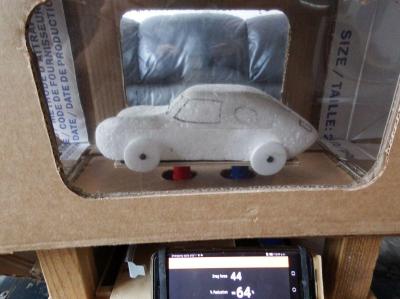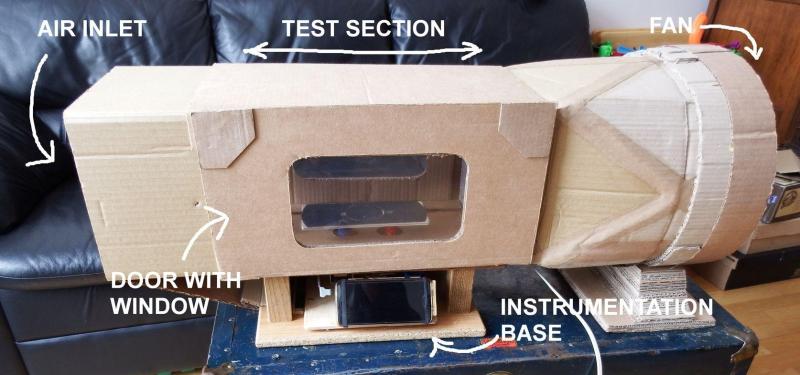We at Hackaday are great fans of hands-on classroom projects promoting science, technology, engineering and math (STEM) subjects – after all, inspiring kids with technology at a young age will help ensure a new generation of hardware hackers in the future. If you’re looking for an interesting project to keep a full classroom busy, have a look at [drdonh]’s latest project: a fully-functional wind tunnel made from simple materials.
 Built from cardboard, it has all the same components you’d find in a full-size aerodynamics lab: a fan to generate a decent stream of air, an inlet with channels to stabilize the flow, and a platform to mount experiments on. There’s even some basic instrumentation included that can be used to measure drag and lift, allowing the students to evaluate the drag coefficients of different car designs or the lift-generating properties of various airfoils.
Built from cardboard, it has all the same components you’d find in a full-size aerodynamics lab: a fan to generate a decent stream of air, an inlet with channels to stabilize the flow, and a platform to mount experiments on. There’s even some basic instrumentation included that can be used to measure drag and lift, allowing the students to evaluate the drag coefficients of different car designs or the lift-generating properties of various airfoils.
The design of these instruments is as clever as it is simple. For measuring drag, [drdonh] made a mass balance out of pieces of wood and plastic film, with a small magnet attached to a long beam bringing it near a smartphone. The phone’s magnetometer can then be used to measure the beam’s deflection, which is a measure of the amount of drag experienced by the device under test.
A second instrument is able to measure the lift and drag of a paper plane, through a device called a drag balance as used by the Wright brothers. Students can change the angle of attack and use the measured lift and drag values to calculate the L/D ratio, which is a measure of the efficiency of gliders – which paper planes essentially are. It’s also possible to visualize a stall condition by increasing the angle of attack until the amount of lift suddenly decreases dramatically.
The cardboard setup might seem a bit fragile, but [drdonh] assures us it survived multiple sessions with classrooms full of giddy students. Wind tunnels are pretty nifty tools to have on your desk anyway: even if you’re not optimizing aircraft designs at mach 20, you can make neat visualizations of the airflow across your car.
















Can you put smoke in it?
Just approach a lighter, it’s cardboard…
Vapes with glycerine probably would work
Wind tunnel that serves as a bong. You set out to optimize car design and instead you end up baked. Friggin awesome.
The only criticism is that the models mentioned in the Instructables article offer significant blockage to the tunnel section so that the flow is significantly affected by the presence of the nearby walls. This prevents a good comparison from one model to the next, likely exaggerating the differences between blunt and more smoothly shaped items. Normally a section blockage of no more than 10% is the limit.
For the rest – a brilliant use of materials, a brilliant adaptation for making drag measurements. It deserves more thumbs up than thumbs I have.
Another DIY wind tunnel:
https://www.apogeerockets.com/education/downloads/Newsletter252_Large.pdf